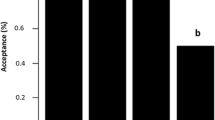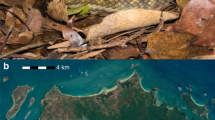Abstract.
Although most insects are vulnerable to predation by a variety of predators, including birds, there are few direct observational studies in the wild of avian predation on adult butterflies. We examined the predatory behavior of smooth-billed anis (Crotophaga ani) on butterflies, and the spacing behavior of the butterflies which were concentrated on a mineral-rich beach on the Cristalino River, in Mato Grosso, Brazil. We studied eight of the most regularly occurring butterfly species which came each morning to engage in "puddling." Most species of butterfly were closely associated with conspecifics, although nearest-neighbor distance varied among species. The pierids – "yellows" (Aphrissa statira, Phoebis trite), "oranges" (Phoebis argante), and sometimes "whites" (Daptoneura leucadia) – formed very dense groups (or clusters) of up to 1,000 individuals occasionally joined by a few kite swallowtails (Eurytides spp.). Most other butterfly species formed small groups (e.g., daggerwings, Marpesia spp.) or were dispersed individually and non-clumped over the beach (e.g., dingy purplewing, Eunica monima). Anis foraged using two strategies: rapid frontal attack on dense groups of butterflies (yellows, oranges, whites), and a stealthy approach to solitary butterflies (mainly purplewings) or those in small groups. For yellows, the most common butterfly caught by anis, the capture rate reached over 6 per 15 min per ani, and about 8% of those captured managed to escape. Capture rates were much lower for the other species. Time of day, age of the ani (adult or young-of-the-year), and total number of each butterfly species present accounted for variation in the number of each species captured by anis. The number of butterflies captured per 15 min increased as the number of butterflies present increased, but reached a threshold beyond which the capture rate did not increase. The capture rate per individual butterfly (individual risk) decreased with group size up to a group of 40 individuals and remained low with further increases. Thus a butterfly in a group of 100 was no less likely to be eaten than one in a group of 40. For individual ani forays into dense groups of pierids, an individual ani was unable to catch more than 16, regardless of group size. These data confirm the dilution effect of group size for butterflies; each individual yellow or orange was less at risk from ani predation when in a group.
Similar content being viewed by others
Author information
Authors and Affiliations
Additional information
Electronic Publication
Rights and permissions
About this article
Cite this article
Burger, J., Gochfeld, M. Smooth-billed ani (Crotophaga ani) predation on butterflies in Mato Grosso, Brazil: risk decreases with increased group size. Behav Ecol Sociobiol 49, 482–492 (2001). https://doi.org/10.1007/s002650100327
Received:
Revised:
Accepted:
Issue Date:
DOI: https://doi.org/10.1007/s002650100327




